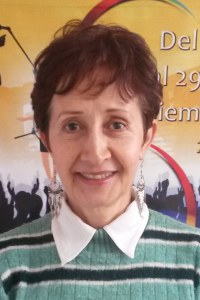

 Laboratorio de Recursos Naturales y Procesos, Dpto. de Industria, Facultad de Ingeniería, Universidad Tecnológica Metropolitana Avda.J.P.Alessandri 1242. 52 2 276 1927igonzalester@gmail.comCamilla, SofíaLaboratorio de Recursos Naturales y Procesos, Dpto. de Industria, Facultad de Ingeniería, Universidad Tecnológica Metropolitana Avda. J.P.Alessandri 1242.scamilla@utem.cl
Laboratorio de Recursos Naturales y Procesos, Dpto. de Industria, Facultad de Ingeniería, Universidad Tecnológica Metropolitana Avda.J.P.Alessandri 1242. 52 2 276 1927igonzalester@gmail.comCamilla, SofíaLaboratorio de Recursos Naturales y Procesos, Dpto. de Industria, Facultad de Ingeniería, Universidad Tecnológica Metropolitana Avda. J.P.Alessandri 1242.scamilla@utem.cl
Quiroz, Mariela
Laboratorio de Recursos Naturales y Procesos, Dpto. de Industria, Facultad de Ingeniería, Universidad Tecnológica Metropolitana Avda. J.P.Alessandri 1242.mquirozduran@gmail.com
Sanfeliú, Teófilo
Unidad de Mineralogía Aplicada y Ambiental. Universidad Jaume I Castellón. España.sanfeliu@camn.uji.esJordán, ManuelDivisión de Edafología y Química Agrícola, Departamento de Agroquímica y Medio Ambiente / Universidad Miguel Hernández / Av. De la Universidad s/n. Edificio Alcudia, Elche, España. 966658416/ Fax: 966658340.manuel.jordan@umh.es
ABSTRACT
ABSTRACT
In the present work there are exhibited pronounced morphologic changes experienced on the different seasonal periods. Also matter of study has been the strong contamination originated in the restaurants of the sector, and big inflow of people in the holiday season.
With regard to the morphology, the sand of the beach is taken by the waves to opensea, appearing the metamorphic outcrop of the crystalline base. A solution to the contamination of the home residues and of restaurants of the area has not been given, depositing these residues by the sewer in a side of the beach.
Key words
Key words
Morphology, contamination, mineralogy.
INTRODUCCIÓN
INTRODUCCIÓN
The city of Viña del Mar has experienced a strong growth in the tourist and hotel sector. Its closeness to the city of Santiago makes it a much visited place all year round. During autumn and winter the population visiting is minor and remains during short periods of time, on the other hand during spring and summer the visitor population increases exponentially for long periods of time. Situation that favors the contamination of the coastal area by anthropogenic action
The area in study is in the coast line of the Region of Valparaiso, between the 32° 43' and 33° 45' south latitude and 71° 27' and 71° 46' longitude west (See Figure N°1) corresponding to a coastal area and of some deposits of lumaquelles and sand. Specifically Cochoa beach between 32° 57' 19,24" south latitude and 71° 32' 57,90 " longitude west corresponding to the north sector of the coast of the Viña del Mar.

Figure Nº1.- Map Cochoa beach location in the Valparaiso Region
SUBJECT
Geologic precedents of the sector
The area is characterized by the presence of metamorphic rocks that reveal part of his geologic history shaped by a period of sedimentation and volcanic activity in Paleozoic Inferior or Precambrian, continued by the distortion and metamorphism regional of the piled up deposits. The action of the metamorphism was accentuated by the intrusion of Batholitic from the Paleozoic, that suffered a granitization process (I. González, 1984).
Methodology of work
The place was studied by means of visiting the area two times a month from November, 2006 until February, 2008, in which the samples were obtained for the petrologic study and logical sediment in laboratory. Observation of the change in morphology in the course of the work period, registered in photos and local measurements.
There is enclosed the scheme of work developed in the laboratory.
Sampling in situ
Sediments
Physical properties
Size distribution Analysis
Mineralogical analysis
Textural parameters
Heavy and light Separation fraction
- Petrographic Microscope
- Study with binocular magnifying glass
- Microscope of polarized light
- Chemical Analysis
Results and classification of the sediment
Figure Nº2.- Scheme of the analytical march developed for the treatment of the samples in the laboratory.

Geomorphology of the Cochoa beach
The beach of Cochoa suffers strong changes throughout the year, the sand that covers the rocky outcrops that fluctuate between 60 cm to 1,20 m of thickness, in the spring summer period is eliminated by the strong autumn and winter tidal waves. Every summer the beach is refilled with sand brought from the closeness to cover the rocks. For a decade the existing dunes have been eliminated largely by the building construction in height which at present constitute a citadel.The new constructions have provoked the partial disappearance of the dunes, allowing an increase in the population density especially in the summer periods, and with it increasing the anthropogenic contamination.
This beach is surrounded by metamorphic rocky outcrops observable in the autumn and winter seasons. There are outcrops that stand out permanently. The beach is divided in a north sector and a south sector, being the north sector the one that suffers major anthropogenic alteration, due to it location in front of the established restaurants.
In the north sector the outcrop of metamorphic rocks interrupted by a melanocratic dike is the ceiling of the course of waters contaminated up to the arrival to the sea. It is the place mainly visited and preferable for the children amusing theme self and bathing in this incipient flow of contaminated water.
Contamination of the Cochoa beach
Cochoa is a gastronomic and residential center in development, inserted in the City of Viña del Mar, therefore bound to the fluctuations of the visitor population and the contamination that it is possible to generate by the wrong use of the coastal area and its surroundings.
With regard to the contamination of the coastal sector not only, one alludes to that one produced directly by some visitors who leave garbage and rests of food in the beach, but also it wants to be made clear that the waste of buildings and gastronomic centers established in the surroundings which are led by sewers when collapsed, are replaced by means of unexpected channels of plastic that cover the beach and coming to the sea (see photo of the Figure Nº3).
In the Figure Nº4 there is observed the flood of the north sector of the beach of Cochoa, when the sewers collapsed in the beach, place intensely visited in the summer period.
Figure Nº3.- Channels of plastic like substitutes of the pipelines of outlet.
Figure Nº4.- Flood of the beach for polluted waters on having collapsed “chambers”.
Results

 |
|||||||||||||||||||||||||||||||||||||||||||||||||
Chart Nº1.- Dimension of the samples areas and numeration of the samples representative of them.
Chart Nº2.- Physical properties of the representative samples
|
|||||||||||||||||||||||||||||||||||||||||||||||||
The local sedimentology gives the following results.
Chart Nº3.- Textural parameters
The analysis of the textural parameters, obtained by means of the method of the statistical moment, threw the following results:
- Both samples (M1 and M2) come from an ambience of beach deposit with strong influence of fluvial ambience, specifically with influence of the Aconcagua River.
- In the sample M1 predominates the very thin sand and in the sample M2predominates sand of average size, both sediments possess good selection.
Grain size distribution
Fraction of size 0.5-0.25 mm: In both samples the magnetic fraction is absent and predominates the light fraction over the heavy fraction (Chart Nº4).
Fraction of size 0.25-0.05 mm: In both samples a low quantity of magnetic fraction appears and it increases, also, the heavy fraction but it keeps on dominating the light fraction (Chart Nº4)
The sample M2 percentage of clay and silt fractions is low (1.02 %), on the other hand in the sample M1 this value increases to 18.19 %.
|
Values measured in % |
Fraction 0.5-0.25 mm |
Fraction 0.25-0.05 mm |
||
|
Sample |
M1 |
M2 |
M1 |
M2 |
|
Magnetic fraction |
- |
- |
4.72 |
6.87 |
|
Non magnetic fraction |
100 |
100 |
95.28 |
93.13 |
|
Heavy fraction |
10.72 |
4.39 |
14.48 |
39.34 |
|
Light fraction |
89.28 |
95.61 |
85.52 |
60.66 |
Chart Nº4.- Magnetic separation of the light and heavy fraction.
Chemical analysis
Analysis of sediments of sample M1.
|
SiO2 |
Al2O3 |
Fe2O3 |
MnO |
MgO |
CaO |
Na2O |
K2O |
TiO2 |
P2O5 |
|
|
% |
71.86 |
9.88 |
5.34 |
0.40 |
1.14 |
0.22 |
9.11 |
1.34 |
0.30 |
0.41 |
Chart Nº5.- Chemical análisis of sample M1.
Mineralogical analysis
|
Values measured in % |
Fraction0.5-0.25 mm |
Fraction0.25-0.05 mm |
||
|
Sample |
M1 |
M2 |
M1 |
M2 |
|
Quartz |
60 |
74 |
38 |
58 |
|
Potassic Feldespar |
4 |
1 |
2 |
- |
|
Ca/Na Feldespar |
18 |
17 |
8 |
12 |
|
Biotite |
- |
- |
4 |
- |
|
Carbonate |
- |
- |
- |
- |
|
Rock fragments |
18 |
8 |
48 |
30 |
Chart Nº6.- Mineralogy of light fractions of samples M1 and M2.
|
Values measured in % |
Fraction0.5-0.25 mm |
Fraction0.25-0.05 mm |
||
|
Sample |
M1 |
M2 |
M1 |
M2 |
|
Melanocratic minerals |
1 |
- |
23 |
1 |
|
Iron oxides |
1 |
- |
5 |
- |
|
Iron hidroxides |
- |
- |
2 |
1 |
|
Leucoxene |
- |
- |
3 |
- |
|
Rock fragments |
37 |
40 |
7 |
- |
|
Alterites |
10 |
30 |
23 |
18 |
|
Zircon |
- |
- |
1 |
1 |
|
Titanite |
1 |
1 |
- |
- |
|
Epidote |
20 |
77 |
53 |
60 |
|
Green Hornblende |
13 |
22 |
43 |
34 |
|
Brown Hornblende |
- |
- |
- |
2 |
|
Actinolite |
1 |
- |
2 |
- |
|
Hypersthene |
- |
- |
1 |
2 |
|
Augite |
1 |
- |
- |
1 |
|
Augite “egirínica” |
1 |
- |
- |
- |
Chart Nº7.- Mineralogy of the heavy fraction of samples M1 y M2.
Petrographic analysis of sample M2 Cochoa beach.

 |
|
Figure Nº5.- Quartz with apatite inclusions. |
Magnified 316 X, cross nicols.

 |
|
Figure Nº6.- Round epidote Magnified 316X Figure Nº7.- Hornblende and Actinolite Magnified:316 X Figure Nº8.- Hypersthene surrounded of a vitreous paste. Magnified: 316 X, cross nicols. |
CONCLUSIONS
The work states that in the course of the year the morphology of the beach experiences deep changes, which are minimized, refilling with sediments of near places.
As for the contamination it registers by means of photos the collapse of the system of sewer pipe in the period of vacationers' major inflow without definitive measures taken to avoid the contact of these vacationers with residual waters especially from the restaurants.
With regard to the statistical parameters they correspond to studies of investigation realized in advance, when big extensions of dunes existed and the beach was not restored year by year with sand proceeding from other sectors, that is to say without anthropogenic sedimentology influence.
The samples M1 and M2, corresponding to beach sediments studied according to his statistical parameters reflect to correspond to beach sediments of thin and average sand with influence of fluvial sediments brought by the coastal current from the Aconcagua river, there being observed also by the same effect pieces of trees caught between the rocks. The Aconcagua river is located in the north sector of the fifth Region.
The mineralogy of the Cochoa beach is defined by the presence of quartz (see photo Nº 5) and calcium and sodium feldspar in the light fraction. In the weighed fraction the mineralogical composition is shaped for green hornblend, epidote and hypersthene (see photos Nº 6, Nº7 y Nº8), alterites and rock fragments mostly proceeding from the dike rich in Fe and Mg minerals and of the rocky local outcrops.
REFERENCIAS
[1] I. González. Tesis para optar al grado de Doctor en Ciencias Químicas.
“Estudio Sedimentológico y mineralógico del Litoral Central de Chile”. Universidad Autónoma de Madrid (1984).
[2] M. Quiroz (2001). Memoria para optar al título de Ingeniero Ejecución en Química.
“Estudio Geoquímico y Mineralógico de los Placeres Auríferos de Carelmapu, X Región. Chile”. UTEM (2001).
[3] I. González, M. M. Jordán, T. Sanfeliú, M. Quiroz, C de la Fuente (2007).
Mineralogy and heavy metal content in sediments from Rio Gato, Carelmapu and Cucao, Southern Chile. Enviromental Geology 52:1243-1251. DOI 10.1007/s00254-006-0562-0.Vol.52, Número 7, Julio 2007.
Papers relacionados














